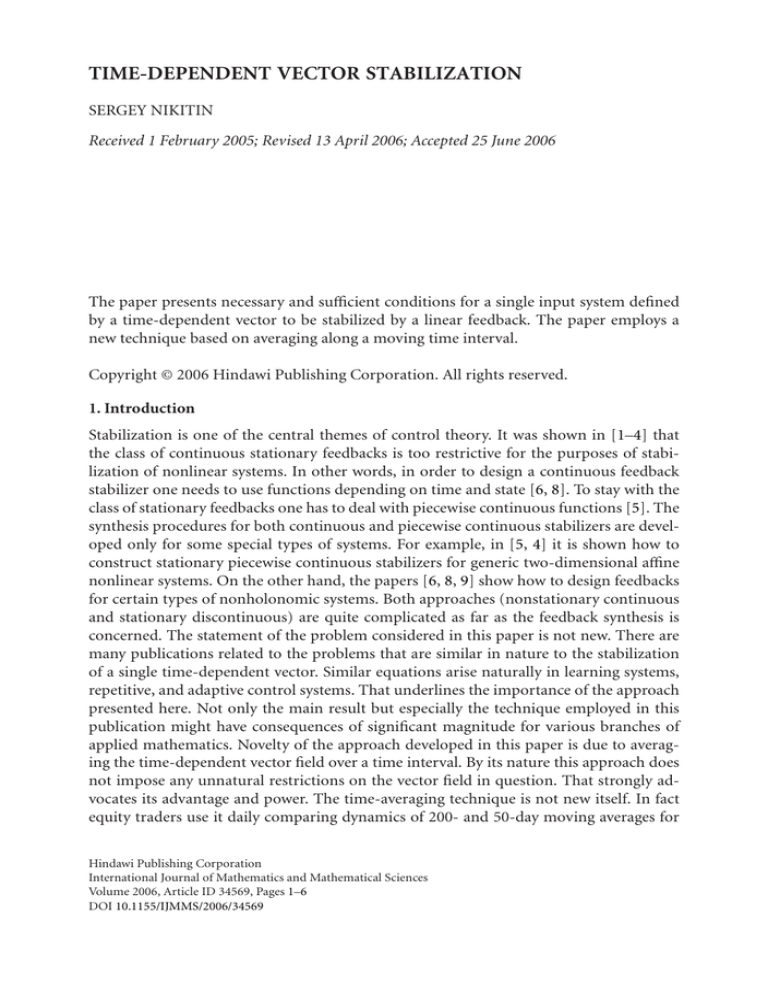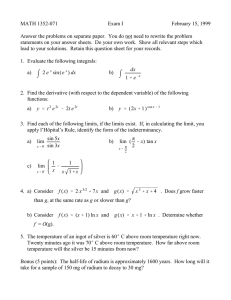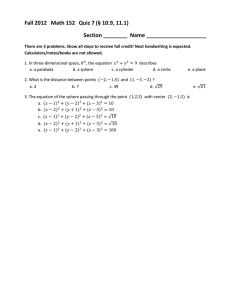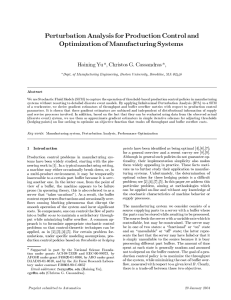
TIME-DEPENDENT VECTOR STABILIZATION
SERGEY NIKITIN
Received 1 February 2005; Revised 13 April 2006; Accepted 25 June 2006
The paper presents necessary and sufficient conditions for a single input system defined
by a time-dependent vector to be stabilized by a linear feedback. The paper employs a
new technique based on averaging along a moving time interval.
Copyright © 2006 Hindawi Publishing Corporation. All rights reserved.
1. Introduction
Stabilization is one of the central themes of control theory. It was shown in [1–4] that
the class of continuous stationary feedbacks is too restrictive for the purposes of stabilization of nonlinear systems. In other words, in order to design a continuous feedback
stabilizer one needs to use functions depending on time and state [6, 8]. To stay with the
class of stationary feedbacks one has to deal with piecewise continuous functions [5]. The
synthesis procedures for both continuous and piecewise continuous stabilizers are developed only for some special types of systems. For example, in [5, 4] it is shown how to
construct stationary piecewise continuous stabilizers for generic two-dimensional affine
nonlinear systems. On the other hand, the papers [6, 8, 9] show how to design feedbacks
for certain types of nonholonomic systems. Both approaches (nonstationary continuous
and stationary discontinuous) are quite complicated as far as the feedback synthesis is
concerned. The statement of the problem considered in this paper is not new. There are
many publications related to the problems that are similar in nature to the stabilization
of a single time-dependent vector. Similar equations arise naturally in learning systems,
repetitive, and adaptive control systems. That underlines the importance of the approach
presented here. Not only the main result but especially the technique employed in this
publication might have consequences of significant magnitude for various branches of
applied mathematics. Novelty of the approach developed in this paper is due to averaging the time-dependent vector field over a time interval. By its nature this approach does
not impose any unnatural restrictions on the vector field in question. That strongly advocates its advantage and power. The time-averaging technique is not new itself. In fact
equity traders use it daily comparing dynamics of 200- and 50-day moving averages for
Hindawi Publishing Corporation
International Journal of Mathematics and Mathematical Sciences
Volume 2006, Article ID 34569, Pages 1–6
DOI 10.1155/IJMMS/2006/34569
2
Time-dependent vector stabilization
prices of securities. However, the mathematical analysis of this idea and its illustration by
the solution of a classical control problem is completely new. Though the method presented by this paper is discussed only in the framework of a single time-dependent vector,
its core ideas are of general nature and will be of great value for system theory. Moreover,
the new technical approach developed in this paper is of fundamental importance and its
further study might promise new advances not only in development of control systems
but also in analysis of general dynamics.
This paper presents a new effective feedback synthesis for stabilization of a timedependent single vector. The proposed synthesis procedure gives us time-dependent linear stabilizers. The paper formulates necessary and sufficient conditions for such stabilizer to make the corresponding closed loop system asymptotically stable.
2. Preliminaries
Consider a system
ẋ = b(t) · u,
(2.1)
where u is the control input; x denotes the state of the system and x ∈ Rn , Rn denotes
n-dimensional linear real space. b(t) is a continuous time-dependent vector field such
that
∀t ∈ R
b(t) ∈ Rn .
(2.2)
Throughout the paper we assume that Rn is equipped with the scalar product and x
denotes the magnitude of x, that is, x = x,x, where x,x is the scalar product of x
with itself.
The goal of this paper is to find necessary and sufficient conditions for the linear feedback
u = − b(t),x
(2.3)
to stabilize the system (2.1). The stabilization is defined as follows.
Definition 2.1. The system (2.1) is said to be stabilizable by the feedback (2.3) if the solution x(t,x0 ) of the closed loop system
ẋ = −b(t) · b(t),x ,
x(0) = x0 ,
(2.4)
tends to zero as t goes to infinity,
lim x(t,x0 ) = 0 ∀x0 ∈ Rn ,
t →∞
(2.5)
and the equilibrium x = 0 is stable.
3. Necessary and sufficient conditions
Our main goal is to find conditions that guarantee that the linear feedback (2.3) stabilizes
the system (2.1). In other words, we need to study asymptotic stability (in large) of the
Sergey Nikitin 3
origin for the closed loop system
ẋ = −b(t) · bT (t)x,
(3.1)
where bT (t), b(t) denote the row and column, respectively. If the feedback (2.3) stabilizes
the system (2.1), then
2
lim x(t,x0 ) = 0 ∀x0 ∈ Rn .
(3.2)
t →∞
Hence, for any fixed real positive number we have
lim
t →∞ 0
−τ
2
x t + τ,x0 dτ = 0 ∀x0 ∈ Rn .
(3.3)
−τ
(3.4)
2
Consider more closely the integral
2
x t + τ,x0 dτ.
2
0
It follows from
d
x t,x0 2 = −2 · b(t),x t,x0 2 ≤ 0
dt
(3.5)
that x(t1 ,x0 )2 ≥ x(t2 ,x0 )2 for t2 > t1 . That means
−τ
2
2
x t + τ,x0 dτ ≥ x t + ,x0 ·
2
0
0
2 dτ = x t + ,x0 · .
2
4
−τ
2
(3.6)
If we find conditions that guarantee
−τ
0
2
2
x t + τ,x0 dτ −→ 0 as t −→ ∞,
(3.7)
then that will imply that the linear feedback (2.3) stabilizes the system (2.1).
Differentiating the integral
−τ
2
x t + τ,x0 dτ
2
0
(3.8)
with respect to time yields
d
dt
− τ 0
2
2
x t+τ,x0 dτ = −
0
( − τ) x t + τ,x0 ,b(t + τ) · bT (t + τ)x t + τ,x0 dτ.
(3.9)
Integrating by parts leads us to the following important formula:
d
dt
0
−τ
2
2
x t + τ,x0 dτ = −
0
x t + τ,x0 ,A(t,τ)x t + τ,x0 dτ,
(3.10)
4
Time-dependent vector stabilization
where
A(t,τ) =
τ
0
b(t + θ) · bT (t + θ) + ( − τ)
· b(t + θ),b(t + τ) · (b(t + θ) · bT (t + τ) + b(t + τ) · bT (t + θ))dθ.
(3.11)
Let
λmax (t,τ)
λmin (t,τ),
(3.12)
denote minimal and maximal eigenvalues of A(t,τ). Then the next theorem gives us necessary and sufficient conditions for the system (2.1) to be stabilized by the linear feedback
(2.3). Notice that one is assured that λmin (t,τ) and λmax (t,τ) are continuous functions of
the variables t and τ by well-known general results on the dependence of the eigenvalues
of a parametric symmetric matrix on the entries of that matrix. It then follows that the
integral expressions in the next theorem are well defined.
Theorem 3.1. If there exists a real number > 0 such that
t
lim sup
t →∞
0
0
λmin (ν,τ)dτ dν = ∞,
(3.13)
then the linear feedback (2.3) stabilizes the system (2.1). On the other hand, if
∃ > 0,
t
lim inf
t →∞
0
0
λmax (ν,τ)dτ dν < ∞,
(3.14)
then the linear feedback (2.3) does not stabilize the system (2.1).
Proof. It follows from (3.10) that
−τ
2
0
2
x t + τ,x0 dτ ≤ −
t
0
+
0
0
2
λmin (ν,τ)x ν + τ,x0 dτ dν
−τ
2
2
x τ,x0 dτ.
(3.15)
Due to monotonicity of x(t,x0 )2 we have
2 4
2
x t + ,x0 ≤ −
t 0
0
2
2 2
λmin (ν,τ)dτ x ν + ,x0 dν + x0 .
4
(3.16)
It follows from the very well-known Gronwall inequality (see, e.g., [7]) that
t
x t + ,x0 2 ≤ x0 2 · exp − 4
λmin (ν,τ)dτ dν .
2 0 0
(3.17)
Thus,
t
lim sup
t →∞
0
0
λmin (ν,τ)dτ dν = ∞
implies that the linear feedback (2.3) stabilizes the system (2.1).
(3.18)
Sergey Nikitin 5
On the other hand, (3.10) leads us to
−τ
2
0
2
x t + τ,x0 dτ ≥ −
t
0
+
0
2
λmax (ν,τ)x ν + τ,x0 dτ dν
−τ
2
x τ,x0 dτ.
2
0
(3.19)
Since the derivative (d/dt)x(t,x0 )2 is not positive we have x(ν + τ,x0 )2 ≤ x(ν,x0 )2
and
2 4
2
x t,x0 ≥ −
t 0
0
2
2
2 λmax (ν,τ)dτ x ν,x0 dν + x ,x0 4
(3.20)
for t ≥ . After solving this inequality we obtain
t
x t,x0 2 ≥ x ,x0 2 · exp − 4
λ
(ν,τ)dτ
dν
max
2 0 0
(3.21)
for t ≥ . Hence, if
∃ > 0,
t
lim inf
t →∞
0
0
λmax (ν,τ)dτ dν < ∞,
then the linear feedback (2.3) does not stabilize the system (2.1).
(3.22)
Notice that we owe the success in proving Theorem 3.1 to the new idea that suggests
to consider
0
−τ
2
2
x t + τ,x0 dτ
(3.23)
instead of x(t,x0 )2 . This approach seems to have further important consequences not
only for control theory but also for studies of general dynamical systems.
4. Example
Theorem 3.1 finds many important applications in control theory. This section illustrates how one can use Theorem 3.1 to analyze and design feedback stabilizers for a twodimensional system defined by a periodic time-dependent vector field.
Consider the system
1
u.
ẋ =
sin(t)
(4.1)
In order to stabilize the system at the origin, one can choose the linear feedback
u(t,x) = − x1 + sin(t) · x2 .
(4.2)
6
Time-dependent vector stabilization
In order to prove that this feedback stabilizes system (4.1) at the origin, we will employ
Theorem 3.1. The matrix A(t,τ) takes the form
A(t,τ) =
τ
0
1
· 1 sin(t + θ) + ( − τ) · 1 + sin(t + θ)sin(t + τ)
sin(t + θ)
·
1
1
· 1 sin(t + τ) +
· 1 sin(t + θ) dθ.
sin(t + θ)
sin(t + τ)
After calculating the integral
t
⎛
t
0 A(ν,τ)dν
τ + α(τ, )
A(ν,τ)dν = t · ⎝
0
0
(4.3)
we obtain
⎞
0
⎠+O 1
τ
+ β(τ, )
t
2
as t −→ ∞,
(4.4)
where the functions α(τ, ) and β(τ, ) are not negative. Hence, by Theorem 3.1 feedback
(4.2) stabilizes system (4.1).
Acknowledgment
The author is very grateful to the referee who made many important suggestions that
allowed to improve the formulation of the main result and the style of the paper.
References
[1] D. Aeyels, Stabilization of a class of nonlinear systems by a smooth feedback control, Systems &
Control Letters 5 (1985), no. 5, 289–294.
[2] J.-M. Coron, A necessary condition for feedback stabilization, Systems & Control Letters 14 (1990),
no. 3, 227–232.
[3] S. Nikitin, Topological necessary conditions of smooth stabilization in the large, Systems & Control
Letters 21 (1993), no. 1, 35–41.
, Global Controllability and Stabilization of Nonlinear Systems, Series on Advances in
[4]
Mathematics for Applied Sciences, vol. 20, World Scientific, New Jersey, 1994.
, Piecewise-constant stabilization, SIAM Journal on Control and Optimization 37 (1999),
[5]
no. 3, 911–933.
[6] J.-B. Pomet, Explicit design of time-varying stabilizing control laws for a class of controllable systems
without drift, Systems & Control Letters 18 (1992), no. 2, 147–158.
[7] N. Rouche, P. Habets, and M. Laloy, Stability Theory by Liapunov’s Direct Method, Applied Mathematical Sciences, vol. 22, Springer, New York, 1977.
[8] C. Samson, Control of chained systems application to path following and time-varying pointstabilization of mobile robots, IEEE Transactions on Automatic Control 40 (1995), no. 1, 64–77.
[9] O. J. Sørdalen and O. Egeland, Exponential stabilization of nonholonomic chained systems, IEEE
Transactions on Automatic Control 40 (1995), no. 1, 35–49.
Sergey Nikitin: Department of Mathematics and Statistics, Arizona State University, Tempe,
AZ 85287-1804, USA
E-mail address: nikitin@asu.edu








